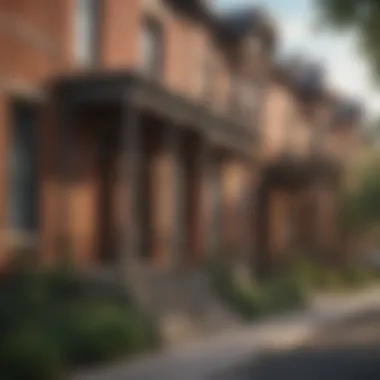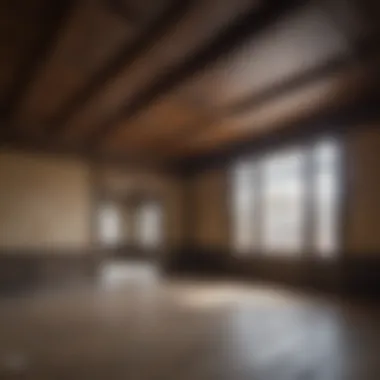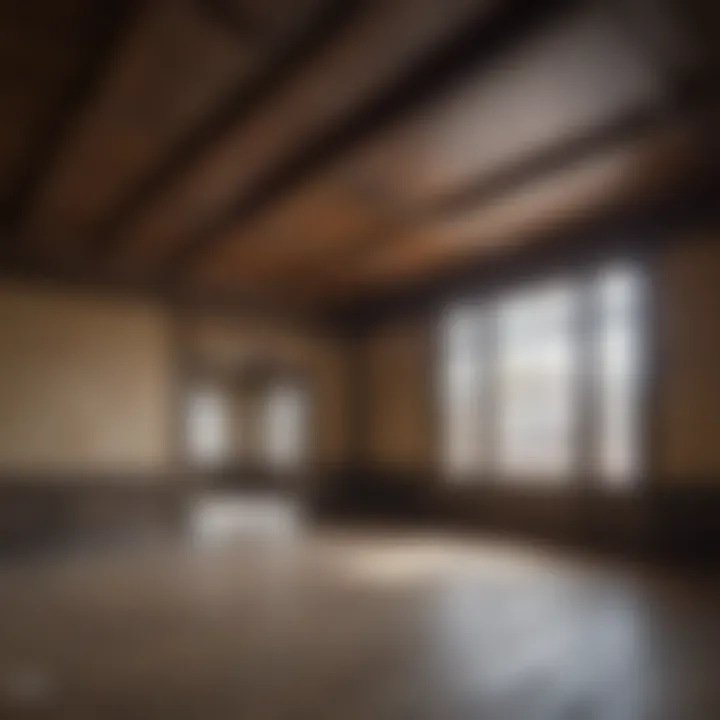Exploring Denver's Historic Apartments: Architecture & Culture


Intro
As one wanders through Denver's historic districts, an array of architectural marvels greets the eye. The city boasts a collection of historic apartments that offer glimpses into an era marked by unique styles and significant cultural shifts. This exploration unveils the nuances of Denver's historic apartments, diving into their architectural significance, the historical contexts that shaped them, and their cultural impact on the urban landscape.
Prospective residents and real estate enthusiasts alike find appeal in these buildings, each with stories woven into their façades. Exploring this topic provides not only an understanding of the apartments themselves but also the ongoing efforts to preserve their essence amidst modern demands.
Featured Homes
Architectural Highlights
Denver’s historic apartments showcase a diverse mix of architectural styles. Notable examples include:
- Victorian Style: These apartments are characterized by intricate woodwork, expansive porches, and vibrant color schemes.
- Art Deco: Emphasizing geometric designs, these buildings often feature sleek lines and ornate detailing.
- Beaux-Arts: Known for their grandeur, these structures incorporate classical elements and elaborate sculptures.
Each style comes with its story, reflecting the tastes and values of the era in which it was built. The Historic Denver organization continues to advocate for the preservation of these architectural masterpieces.
Interior Design Themes
Inside these historic apartments, one can often observe a fusion of past and present. Period details such as crown moldings, hardwood floors, and original fireplaces coexist with contemporary furnishings. Common interior themes include:
- Restoration of Original Features: Many homeowners strive to maintain features like stained glass windows and tin ceilings, which highlight the building's history.
- Eclectic Blends of Time: The mix of vintage and modern decor creates unique living spaces, appealing to both history enthusiasts and modern aesthetics.
Homeowners are encouraged to respect the character of these spaces while employing modern design principles.
Location Spotlights
Cultural Significance
The neighborhoods housing historic apartments are themselves rich with culture. Areas like Capitol Hill and Five Points serve as historical and cultural hubs. Walking tours in these neighborhoods reveal insights into the community’s evolution.
Denver’s historic districts invite exploration through their art galleries, museums, and public spaces, contributing to a vibrant cultural fabric. Investing in these historic homes often means becoming part of a legacy that appreciates the past while looking forward to the future.
Natural Wonders
The juxtaposition of historic architecture and Denver's natural surroundings is striking. The Rocky Mountains provide a dramatic backdrop to the city, enhancing the charm of various neighborhoods. Many historic apartments benefit from proximity to parks such as the City Park and Washington Park, offering residents a blend of urban living with access to nature. The contrast between the landscape and architectural beauty creates a unique living environment that appeals to many.
"Preserving the past while embracing the future creates a vibrant continuity in urban living."
In summary, Denver's historic apartments represent a confluence of history, culture, and modernity. They embody tales of the city's development while catering to contemporary lifestyles. Understanding these aspects offers prospective residents and real estate enthusiasts a deeper appreciation of what it means to live in a historic property.
Prelude to Historic Apartments
Historic apartments in Denver serve as a window into the city's past, reflecting the architectural trends and cultural dynamics of their respective eras. These buildings are not merely living spaces; they tell stories of the people who inhabited them, the events that took place around them, and the evolution of the urban landscape.
Understanding the significance of historic apartments extends beyond appreciating their aesthetic appeal; it encompasses recognizing their value in preserving the heritage of the city.
Definition and Importance
Historic apartments are generally defined as residential buildings that have retained their architectural integrity and historical significance. They often feature distinct styles that reflect the time in which they were built. These structures provide a sense of continuity in an ever-changing city.
The importance of these apartments lies not just in their design but also in their cultural and social context. They contribute to the identity of neighborhoods, offering a glimpse into Denver's evolution over the years. Residents and visitors alike benefit from engaging with these buildings, which provide insights into the past while enriching the urban experience.
Overview of Denver's Architectural Evolution
The architectural landscape of Denver has gone through significant changes since its inception. Initially shaped by the Gold Rush of the mid-19th century, the city saw a surge in construction focused on practicality and utility. As wealth flowed into the city, more elaborate designs emerged, showcasing styles such as Victorian, Arts and Crafts, and later, Art Deco.
In the mid-20th century, Mid-Century Modernism gained popularity, bringing a fresh perspective to urban design. Each of these periods left an indelible mark, resulting in neighborhoods that boast a rich tapestry of architectural styles. While some historic apartments are now seen as relics, they also represent adaptability, merging old elements with new uses, thereby continuing to populate the cityscape.
The Architectural Landscape of Denver


The architectural landscape of Denver is a rich tapestry that reflects the city's historical journey and cultural evolution. Each building tells a story that connects the past with the present. This section delves into the diverse architectural styles found in the city's historic apartments. Understanding these styles is essential, as they not only define the aesthetic appeal but also contribute to the identity of various neighborhoods.
Key Architectural Styles in Historic Apartments
Victorian Architecture
Victorian architecture is a prominent feature in Denver's historic apartments. This style emerged during Queen Victoria's reign, resulting in intricate details and ornate design. Key characteristics include asymmetrical shapes, bay windows, and elaborate trim. The inclusion of porches and decorative bracket supports makes Victorian buildings visually captivating.
These apartments offer a glimpse into a bygone era, often appealing to those who appreciate craftsmanship and attention to detail. However, maintenance can be more challenging due to the intricate designs. Homeowners may face higher restoration costs, but the aesthetic and historical value often justifies this.
Art Deco Influence
Art Deco influence marks a shift towards modernity within Denver's architectural landscape. Associated with the 1920s and 1930s, this style showcases bold geometric shapes, vibrant colors, and streamlined forms. One key characteristic is the decorative elements that often feature sunbursts and zigzags, which can be seen in various historic apartments throughout the city.
Art Deco buildings present a sense of sophistication and glamour. Their unique features often attract buyers looking for character in their living spaces. However, the challenge lies in the preservation of these distinct design elements while accommodating modern building codes.
Mid-Century Modernism
Mid-Century Modernism represents a reaction to previous architectural styles, focusing on simplicity and functionality. Common features include open floor plans, large glass windows, and integration with nature. This style reflects the post-World War II optimism that shaped many American cities, including Denver.
Mid-Century apartments often appeal to those seeking a minimalist aesthetic. They provide seamless indoor-outdoor living spaces, which is ideal for Colorado's climate. On the downside, these structures may lack the ornate details found in older styles. Therefore, some may perceive them as less characterful compared to their Victorian counterparts.
Notable Historic Districts
Capitol Hill
Capitol Hill is a vibrant neighborhood, known for its eclectic mix of architectural styles. Its historic apartments reflect diverse influences, making it a magnet for artists and young professionals. The area is characterized by a rich cultural presence, with many buildings dating back to the late 19th century.
Its unique ambiance fosters a sense of community, drawing residents who value urban living with a historical backdrop. However, the growing demand for real estate can introduce challenges in maintaining the existing character of the neighborhood amid modern developments.
Lodo (Lower Downtown)
Lower Downtown, or LoDo, is one of the oldest neighborhoods in Denver, boasting a mix of historic warehouses and converted apartment buildings. The charm of exposed bricks and large windows lends a unique character to these spaces. In recent years, LoDo has seen revitalization, attracting new residents while still honoring its historical roots.
This blend of old and new cultivates an appealing lifestyle, but it can also bring gentrification challenges. Maintaining affordability is essential in preserving the neighborhood's authentic charm.
Five Points
Five Points holds a significant place in Denver's African American history. Known for its rich cultural contributions, it features several historic apartments that have historical importance. The area's unique architecture often reflects the social dynamics that shaped it.
Residents are drawn to its vibrant neighborhood culture and historical significance. However, similar to other districts, it faces modernization pressures. Balancing development while honoring the culture is a task for current and future generations.
"Each neighborhood in Denver showcases the historical evolution of architecture. Understanding these styles provides insight into the city’s cultural narrative."
Overall, the architectural landscape in Denver is not just about buildings; it is about the stories they tell and the people who inhabit them. By appreciating and protecting these historic apartments, we can ensure the continued richness of Denver's urban fabric.
Historical Context of Denver's Apartments
Understanding the historical context of Denver's apartments is crucial for a comprehensive view of their significance. This context not only highlights the evolution of architectural styles and urban development but also illuminates the social, cultural, and economic factors that shaped the city. The rich history behind these apartments serves to enhance their appeal, making them attractive to potential residents and investors alike.
Denver During the Gold Rush Era
The Gold Rush era, commencing in 1858, was a transformative period for Denver. It prompted a surge in population, as prospectors and settlers flocked to the area in search of wealth. During this time, the construction of apartments began to take hold. Many of these early buildings were constructed hastily, using available materials. Their primary purpose was to house the growing population of miners and entrepreneurs.
The architecture from this period reflects a diversity driven by necessity and opportunity. Buildings were often designed in simple styles, but some showcased elements of Victorian architecture as the prosperity grew. The influx of residents led to the establishment of a vibrant community. This community valued not only economic growth but also social connections, which were often fostered in shared living spaces. Denver's historic apartments from this time period are important relics that narrate the story of convergence between diverse cultures and backgrounds.
Post-War Developments and Changes
The post-World War II era brought about significant changes in Denver's urban landscape. As returning veterans reintegrated into civilian life, there was a high demand for housing. This led to the construction of many new apartments and the renovation of older buildings. Unlike the rushed constructions of the Gold Rush era, the focus now shifted toward more thoughtful architectural innovations.


During this period, many historic apartments were updated to meet modern needs, such as greater accessibility and improved amenities. However, this practical development came with challenges. Balancing modernization with preservation efforts became crucial for maintaining Denver's unique architectural heritage. As the demand for housing persisted into the late 20th century, many historical apartments were at risk of being neglected or demolished.
In summary, the historical context of Denver's apartments is shaped by events like the Gold Rush and post-war developments. Each period introduced new social dynamics and architectural styles, creating a tapestry of history available for exploration today. Understanding these elements informs the current appreciation for Denver's historic apartments, showcasing their importance and potential for the future.
The Appeal of Historic Apartments
Historic apartments in Denver hold a unique allure that attracts various groups, from homebuyers to design enthusiasts. The charm of these residences goes beyond mere aesthetics; it encompasses a rich tapestry of cultural heritage, community ties, and architectural integrity. Understanding this appeal can provide insight into why these spaces remain sought after in the dynamic Denver real estate market.
Cultural Significance and Community
Culturally, historic apartments serve as living reminders of Denver's past. They reflect the social and economic evolution of the city. Many of these buildings were constructed during pivotal moments in Denver’s history, particularly during the Gold Rush and subsequent urban expansions. This provides residents with a sense of connection to the city's narrative.
Living in a historic apartment often means becoming part of a vibrant community. Residents share an appreciation for history and culture. These buildings frequently host a sense of camaraderie among neighbors, fostering relationships rooted in shared interests. Community events, local art showcases, and historical tours are common in neighborhoods with significant historic apartments such as Capitol Hill or Five Points. This reinforces local identity and encourages community involvement.
Character and Unique Features
The architectural character of historic apartments is another significant factor in their appeal. Each property often embodies a distinct style representing different periods in Denver's architectural evolution. For example, elements of Victorian architecture such as intricate woodwork and decorative façades can be found alongside Art Deco details in other buildings. These unique features contribute to the individuality of each apartment, setting them apart from newer developments.
Moreover, the original craftsmanship in historic apartments is something new constructions often lack. High ceilings, large windows, and original hardwood floors are characteristics many residents find appealing.
Also, the layout of these apartments tends to offer greater flexibility than modern designs, accommodating various living arrangements and personal preferences. Residents have the opportunity to customize their spaces, honoring the building's history while integrating contemporary design elements that suit their lifestyles.
In summary, the combined cultural significance and unique characteristics of historic apartments in Denver create an environment that is as enriching as it is livable. These spaces not only provide shelter but also connect residents with a deeper sense of community and history.
Restoration and Preservation Efforts
Restoration and preservation of historic apartments in Denver hold critical importance in maintaining the cultural fabric of the city. These efforts aim not only to conserve the aesthetic and historical value of architectural landmarks but also to promote sustainable living. By preserving these buildings, we acknowledge the past and enhance the sense of community in neighborhoods.
The benefits of restoration extend beyond just aesthetics. Historic buildings are often constructed with quality materials and craftsmanship that modern structures may lack. Restoring these properties can lead to an increase in property values, which in turn boosts local economies. Moreover, preserved historic apartments provide unique housing options that attract diverse residents seeking charm and authenticity.
However, the challenges related to such restoration projects are significant. Balancing the demands of modern living with the need to honor the past requires careful consideration. Property owners and developers must navigate various regulations and guidelines that govern preservation efforts, adding layers of complexity to their projects.
Challenges in Restoring Historic Properties
Restoring historic properties brings forth several challenges that can complicate efforts. Many of these buildings may require substantial updating to meet safety codes and modern standards. Common issues include outdated electrical systems, plumbing, and insulation. Addressing these problems while preserving the original character of the building is no simple task.
Additionally, funding can be a major hurdle. Restoration projects often demand significant financial investments. Securing grants or tax incentives for preservation can be competitive and time-consuming. Furthermore, the sourcing of authentic materials for replacement can also prove difficult. When original materials are no longer available, finding a suitable alternative that maintains the building's integrity becomes a priority.
"Restoration of historic apartments is more than just building work; it is a commitment to preserving a city’s identity."
Preservationists must also understand the community's values. Every neighborhood has its own history and character. Restoration efforts must take into account the wishes and needs of the local community, fostering their involvement to create a sense of ownership over their shared history.
Successful Case Studies in Denver
In recent years, Denver has seen notable success in restoring its historic apartments. One prominent example is the renovation of the Mackey Apartments. Located in the Capitol Hill neighborhood, this project not only restored the building's exquisite early 20th-century details but also modernized its amenities, providing residents with a comfortable living environment without losing the property's historical essence.
Another successful case study is the Cunningham Mansion. This elegant brick structure formerly served as a boarding house and has now been transformed into luxury apartments. The preservation team focused on retaining key architectural features while improving energy efficiency. This conscious adaptation demonstrates how historic properties can evolve to meet contemporary expectations.
Lastly, the Fourteenth Street Historic District also showcases successful preservation efforts, where several buildings have been carefully restored for residential use. The vibrancy of this area is a testament to how thoughtful restoration can breathe new life into historic neighborhoods, ensuring they remain relevant and loved by the community.
Restoration and preservation endeavors in Denver capture not just physical structures but the stories and histories they hold. These efforts are essential for maintaining the identity of the city, ensuring that future generations can enjoy and learn from these historic apartments.
Modern Living in Historic Apartments
In recent years, the concept of modern living within historic apartments has gained considerable traction, especially in urban centers like Denver. This trend reflects a broader cultural shift toward valuing historical significance while embracing contemporary comforts. Combining these two seemingly opposing elements poses unique challenges and opportunities that are worth exploring. A harmonious blend of the past and the present can enhance not only the aesthetic appeal of living spaces but also their functionality and market value.
Combining Modern Amenities with Historic Charm
Historic apartments often come with character-defining features, such as ornate moldings, exposed brick walls, and high ceilings. However, the demands of 21st-century living necessitate the integration of modern amenities. This includes everything from smart home technologies to energy-efficient appliances.


An important aspect of this integration is maintaining the integrity of the original architecture while upgrading to more current standards. Homeowners and developers must navigate the delicate balance of respecting the building's historical value while providing comfort and convenience. For example, updated kitchens and bathrooms can be equipped with discreet modern fixtures that do not detract from the overall charm of the apartment.
- Energy-efficient HVAC systems can be installed without compromising aesthetic integrity.
- Smart lighting systems can be incorporated to enhance both ambiance and energy savings.
Locally, many developers employ skilled craftsmen who specialize in preservation. Their expertise ensures that changes are made thoughtfully and respectfully, contributing to the building's longevity without overshadowing its historical essence.
Adapting Spaces for Contemporary Needs
The needs of today's residents are inherently different from those of previous generations. Open-concept layouts, for instance, have become a desirable feature in many new homes. Adapting historic apartments to meet these contemporary preferences often involves reconfiguring floor plans without losing essential period details.
In Denver, some historic apartments have successfully transformed narrow hallways into useful spaces. This can include creating small nooks for workstations, incorporating storage solutions, or even adding elements like built-in shelving that harmonizes with the existing architecture.
- Flexible living areas allow residents to use their space as required.
- Multi-functional furniture can adapt to various needs, providing additional style and functionality.
These adaptations not only serve individual lifestyles but also contribute to a more sustainable approach to living. By making the most of existing structures, urban sprawl can be mitigated, and the community's historical footprint preserved.
"The intersection of modern living and historic preservation reflects the dynamic nature of urban life. It engages residents in a dialogue with their city's past while using tools of the present."
In summary, modern living in historic apartments embodies a unique synergy. By merging modern amenities with historical charm and adapting spaces to meet contemporary demands, these residences offer a rich living experience rooted in Denver's diverse history.
Market Trends for Historic Apartments
Understanding the market trends for historic apartments in Denver is essential. This section explores specific elements that shape this unique market. The appeal and value of historic apartments reflects not only the historical significance but also their current positioning in Denver's real estate landscape.
Current Real Estate Landscape
The current real estate landscape in Denver is vibrant yet complex. The demand for historic apartments is driven by several factors: their architectural uniqueness, cultural significance, and prime locations. Many buyers are attracted to the charm of historic properties, differentiating them from newer constructions. Moreover, the rise of urban living and the desire for environmentally sustainable options also contribute to the desirability of these apartments.
Recent trends indicate an increased interest from millennials and retirees alike, who seek the distinct character that historic apartments offer. This demographic shift is redefining what potential homeowners prioritize, placing a higher value on community and authenticity
In terms of pricing, historic apartments have seen an upward trajectory. Buyers are willing to invest in properties that promise not just a home but a piece of history. Moreover, the preservation efforts and renovations help maintain high resale values, making these apartments a sound investment.
Investment Opportunities in Historic Properties
Investment opportunities in Denver's historic properties present both advantages and risks.
- Potential for High Returns: As interest in sustainable living grows, the value of historic apartments increases in potential. Investors can capitalize on this trend by purchasing properties, improving them, and renting or selling at a higher price.
- Tax Incentives: Owners of historic properties may benefit from various tax incentives. Programs that encourage preservation efforts can help offset costs. This is an attractive feature for investors keen on maximizing profit margins.
- Community and Cultural Preservation: Investing in historic apartments often supports local communities. These investments help keep the unique cultural heritage of neighborhoods intact and can foster a sense of pride among residents.
However, it’s important for investors to conduct thorough research. The restoration of historic properties can involve specific regulations and challenges, impacting both time and resources. Understanding this dynamic helps mitigate risks associated with such investments.
"Investing in historic apartments not only sustains the character of Denver but assures a strong market presence for years to come."
End
The section on the conclusion is crucial in encapsulating the myriad elements discussed throughout this article. It serves as a synthesis, drawing together insights about Denver's historic apartments, emphasizing their architectural, cultural, and economic significance within the cityscape. By highlighting the complex interplay between restoration efforts and the necessity for modern adaptation, the conclusion underscores the importance of preserving history while accommodating contemporary needs.
The Future of Historic Apartments in Denver
As Denver continues to grow, the future of historic apartments remains an area ripe for both challenges and opportunities. More individuals are looking for residences that offer uniqueness and a story. Historic apartments provide that, coupling charm with character.
Urban developers face pressure to maximize the potential of land, often pointing to redevelopment as more profitable. However, there is a growing awareness and appreciation among residents for maintaining historical integrity. Factors such as local policies aimed at preservation, community interest, and increasing awareness of sustainable living practices are shaping this future.
Key Considerations for Historic Apartments:
- Market Demand: The desire for character-filled spaces amid a sea of modern condos.
- Regulatory Frameworks: Laws and guidelines aimed at protecting historic buildings can influence investment decisions.
- Sustainability: Incorporating green technologies into historic structures is essential as the focus on eco-friendly living intensifies.
Final Thoughts on Preservation and Adaptation
Preservation and adaptation of historic apartments represent a balancing act between honoring the past and embracing the future. This dynamic is essential for prospective residents, who often seek homes that reflect their values and lifestyle choices while still resonating with historical narratives.
The act of preserving Denver's historic apartments goes beyond maintaining aesthetics; it includes fostering a sense of community and identity. It is about enhancing the livability of spaces that have seen the evolution of the city itself.
To ensure that these spaces thrive:
- Residents and investors must collaborate with local officials to navigate regulations pertaining to renovations.
- Community engagement is paramount, allowing those who inhabit these apartments to voice their needs and concerns.
- Festivals, tours, and educational programs can increase awareness, prompting appreciation for historic significance.
As we move into the future, it is imperative to seek harmony between development and heritage. Historic apartments are not just relics of the past but vital components of Denver’s vibrant narrative. They connect us to our origins and offer insights into the future of urban living.







